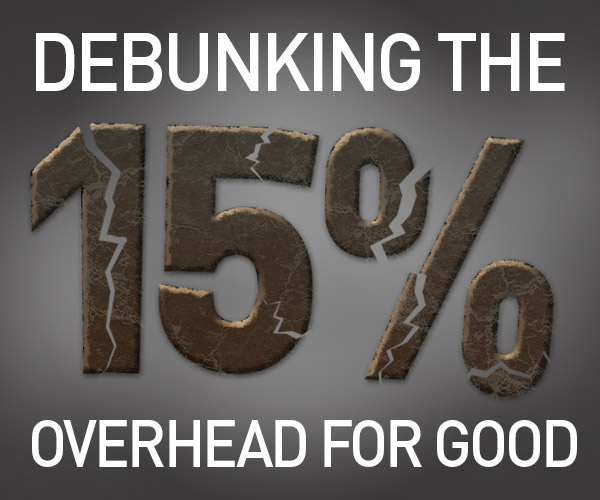Can we please stop the management consultants and charity evaluators of the world from poisoning the water with their mantra of 15% overhead? I know they mean well, but constantly harping on this 15% ideal is simplistic and is causing great harm to many wonderful, worthy organizations.
Without lots of background information, detailed financials, and an in-depth analysis of an organization, 15% overhead is meaningless. Donors will rarely have all that information – and generally don’t want to do that much analysis before making a gift.
In fact, GuideStar, BBB and Charity Navigator partnered in a campaign to end the Overhead Myth – the false conception that financial ratios are the sole indicator of nonprofit performance—by encouraging donors to focus on broader factors such as transparenc y, governance, leadership, and results, as well as finances.
y, governance, leadership, and results, as well as finances.
Here are my top five reasons why 15% might be meaningless:
#5 Organizations Account for Costs Differently
What’s overhead for one organization is a program cost for another. Plus, larger, more sophisticated organizations are more likely to have strategic business staff who know how to allocate costs more effectively among programs.
#4 Start-Up Programs and New Organizations Need to Invest in Infrastructure
Just getting a new program or organization operational can take a significant amount of investment, most of which would be called overhead. And a new program for a small organization will impact the overhead line much more than it will for a large one, which can sooner absorb those costs and might already have the economy of scale to run it.
#3 Some Programs are Simply More Costly to Run
Daycare, mental health, medical services, and other similar organizations require significant oversight, detailed accounting, and inventorying, and massive amounts of reporting. So a grant to run a mental health clinic will take much more staff time to manage than a grant to put on an art exhibition. Much of this becomes overhead, and will put the mental health organization at a disadvantage regardless of the quality of the program.
#2 Costs Vary Across the Country
Try running a theater company in New York City as opposed to Chicago (two cities I know well). It will cost significantly more to house the administrative staff in New York than in Chicago, and due to the high cost of housing in New York City salaries tend to be higher.
You need just as much administrative staff in both cities to run comparable organizations, so generally the overhead cost in New York City, all other things equal, will be higher.

#1 Overhead is Not an Indication of Impact
At the end of the day, the question is whether people and communities are being impacted. And that has only marginal relationship to overhead. There’s nothing to say that people are being impacted less when the overhead costs run to 20%. And just because overhead jumps one year due to some investment in infrastructure doesn’t mean less impact has been made. The organization is smartly planning for greater impact going forward.
So while analysis is important, and organizations should be transparent and accountable, there is no substitute for getting to know an organization personally, seeing programs in action and understanding the impact they’re making, and coming to believe in the staff and their ability to manage. Let’s help donors build stronger relationships with their charities and cast aside these generic litmus tests that don’t begin to honor the diversity and magnificence of our non-profit community.


 like us on facebook
like us on facebook follow us on twitter
follow us on twitter connect on linkedin
connect on linkedin


